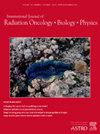自动发现头颈部癌症患者 3 年生存率、吞咽困难和口腔异味预测因素和阈值的新型统计学-人工智能方法
IF 6.4
1区 医学
Q1 ONCOLOGY
International Journal of Radiation Oncology Biology Physics
Pub Date : 2024-10-01
DOI:10.1016/j.ijrobp.2024.07.062
引用次数: 0
摘要
目的/目标 临床医生会反复调整治疗方法以改善疗效,但迄今为止,还缺乏在进行这些调整时持续学习风险因素的自动化方法。我们将大规模、全面的真实世界学习健康系统基础设施(LHSI)与自动统计分析、可视化和人工智能(AI)方法相结合,测试基于证据发现头颈癌患者吞咽困难、口腔异物感和3年生存期这三个终点的临床因素。综合人口统计学、诊断和分期、健康社会决定因素测量、化疗、放疗剂量体积直方图曲线、治疗细节、实验室值和 LHSI 的结果等信息,筛选出 485 个候选特征的证据。使用自举重采样法进行单变量统计分析,以详细确定以下阈值和指标的置信区间:曲线下面积(AUC)、灵敏度(SN)、特异性(SP)、F1、诊断几率比(DOR)、Wilcoxon Rank Sum (WRS)、Kolmogorov-Smirnov (KS)的P值,以及详细预测单个特征证据的Logistic拟合分布。通过使用训练集(70%)、验证集(10%)和测试集(20%)进行 10 倍交叉验证,构建了准 XGBoost 模型。结果治疗 1 年内吞咽困难≥ 3 级的发生率较低(11%)。口腔异味≥2级的发生率(39%至16%)和≤3年的存活率在时间范围内有所下降(25%至15%)。2级口腔异味的最强预测因子是Glnd_Submand_Low:D15% [Gy] ≥ 45.2,其逻辑模型量化了逐渐而非突然增加的概率(13.5 + 0.18 (x-41.0 Gy))。3年后死亡可能性降低的最强预测因素是GTV_高:体积[cc]≤21.1,GTV_低:体积[cc]≤57.5,基线中性粒细胞-淋巴细胞比率(NLR)≤5.6,单核细胞-淋巴细胞比率(MLR)≤0.56,血小板-淋巴细胞比率(PLR)≤202.5。所有预测因子的 WRS 和 KS P 值均为 0.02。通过统计分析,可以详细了解 XGBoost 模型在单个特征方面的收益。结论LHSI、统计剖析和人工智能的结合使用为基于证据的自动发现提供了基础。将人工智能模型与简单的概率模型进行比对,可以了解哪些结果是由总体风险的一般领域驱动的,哪些是由更复杂的相互作用驱动的。这种方法可以形成一种新的方法,用于持续学习和循证开发临床试验可检验的假设和分层。本文章由计算机程序翻译,如有差异,请以英文原文为准。
Novel Statistical-AI Method to Automate Discovery of Predictive Factors and Thresholds for 3 Year Survival, Dysphagia and Xerostomia for Patients with Head and Neck Cancers
Purpose/Objective(s)
Clinicians iteratively adjust treatment approaches to improve outcomes, but to date, automatable approaches for continuous learning of risk factors as these adjustments are made are lacking. We combined a large-scale, comprehensive real-world Learning Health System infrastructure (LHSI), with automated statistical profiling, visualization, and artificial intelligence (AI) approach to test evidence-based discovery of clinical factors for three endpoints: dysphagia, xerostomia, and 3-year survival for head and neck cancer patients.
Materials/Methods
Records for 964 patients treated for head and neck cancers with conventional fractionation between 2017 and 2022 were used. Combined information on demographics, diagnosis and staging, social determinants of health measures, chemotherapy, radiation therapy dose volume histogram curves, treatment details, laboratory values, and outcomes from the LHSI to winnow evidence for 485 candidate features. Univariate statistical profiling was performed using bootstrap resampling to detail confidence intervals for the following thresholds and metrics: area under the curve (AUC), sensitivity (SN), specificity (SP), F1, diagnostic odds ratio (DOR), P values for Wilcoxon Rank Sum (WRS), Kolmogorov-Smirnov (KS), and logistic fits of distributions detailed predictive evidence of individual features. Parsimonious XGBoost models were constructed with 10-fold cross validation using training (70%), validation (10%), and test (20%) sets. Probabilistic models utilizing statistical profiling logistic fits of distributions were used to benchmark XGBoost models.
Results
Incidence of dysphagia ≥ grade 3 within 1 year of treatment was low (11%). Xerostomia ≥ grade 2 (39% to 16%) and survival ≤ 3 years decreased (25% to 15%) over the time range. The strongest grade 2 xerostomia predictor was Glnd_Submand_Low: D15% [Gy] ≥ 45.2 with a logistic model quantifying a gradual rather than an abrupt increase in probability (13.5 + 0.18 (x-41.0 Gy)). Strongest predictive factors for lower likelihood of death by 3 years were GTV_High: Volume [cc] ≤ 21.1, GTV_Low: Volume [cc] ≤ 57.5, Baseline Neutrophil-Lymphocyte Ratio (NLR) ≤ 5.6, Monocyte-Lymphocyte Ratio (MLR) ≤0.56, Platelet-Lymphocyte ratio (PLR) ≤ 202.5. All predictors had WRS and KS P values < 0.02. Statistical profiling enabled detailing gains of XGBoost models with respect to individual features. Time period reductions in distribution of GTV volumes correlated with reductions in death by 3 years.
Conclusion
Combined use of LHSI, Statistical Profiling and Artificial Intelligence provided a basis for automating evidence-based discovery. Benchmarking AI models with simple probabilistic models provided a means of understanding when results are driven by general areas of overall risk vs. more complex interactions. The method can form a new approach to continuous learning and evidence-based development of clinical trial testable hypothesis and stratifications.
求助全文
通过发布文献求助,成功后即可免费获取论文全文。
去求助
来源期刊
CiteScore
11.00
自引率
7.10%
发文量
2538
审稿时长
6.6 weeks
期刊介绍:
International Journal of Radiation Oncology • Biology • Physics (IJROBP), known in the field as the Red Journal, publishes original laboratory and clinical investigations related to radiation oncology, radiation biology, medical physics, and both education and health policy as it relates to the field.
This journal has a particular interest in original contributions of the following types: prospective clinical trials, outcomes research, and large database interrogation. In addition, it seeks reports of high-impact innovations in single or combined modality treatment, tumor sensitization, normal tissue protection (including both precision avoidance and pharmacologic means), brachytherapy, particle irradiation, and cancer imaging. Technical advances related to dosimetry and conformal radiation treatment planning are of interest, as are basic science studies investigating tumor physiology and the molecular biology underlying cancer and normal tissue radiation response.

 求助内容:
求助内容: 应助结果提醒方式:
应助结果提醒方式:


